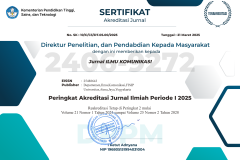Public Relations Education at the Crossroad: Trend and Realities.
DOI:
https://doi.org/10.24002/jik.v5i2.209Abstract
Abstract: This paper explores the issues of public relations academics credentials on teaching public relations at undergraduate level. Generally, most Asian universities look to the United States education system as the ideal model in developing their own curricula, and frequently invite American professors as visiting fellows to help set up their programmes. In addition, Asian universities, including those in Malaysia and Indonesia still harbour the view that the US offers the best public relations education and practices, and therefore follow the US model regarding any matters related to curriculum, study materials, teaching modules, learning resources and the structure of exam papers. Whilst seeming efficient, as the US leads the fields of public relations, it appears to be done blindly without considering such variables as the encompassing political, economic, legal, media and cultural factors of the society adapting these curricula that should determine the roles and functions of public relations practitioners in any given country. This paper concludes that US still offers the best public relations education in comparison to any Asian universities due to lack of academic credentials.
Downloads
Published
How to Cite
Issue
Section
License
Jurnal ILMU KOMUNIKASI is an academic journal. As such, it is dedicated to the open exchange of information. For this reason, JIK is freely available to individuals and institutions. Authors who publish in Jurnal ILMU KOMUNIKASI will release their articles under the Creative Commons Attribution (BY) License. This license allows anyone to copy and redistribute the article in any medium or format as well as remix, transform, and build upon the material for any purpose, even commercially as long as they credit the authors for the original creation. For details of the rights authors grants users of their work, see the "human-readable summary" of the license, with a link to the full license. (Note that "you" refers to a user, not an author, in the summary)
 This work is licensed under a Creative Commons Attribution 4.0 International License.
This work is licensed under a Creative Commons Attribution 4.0 International License.














